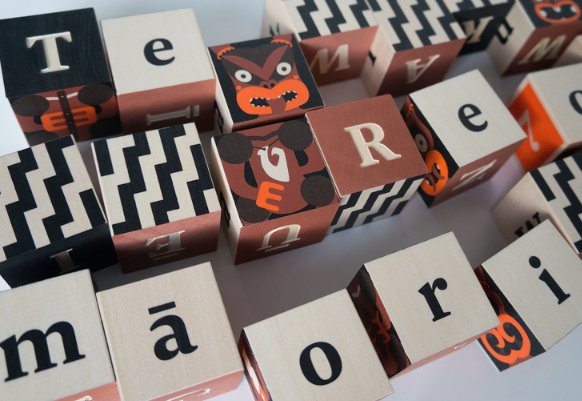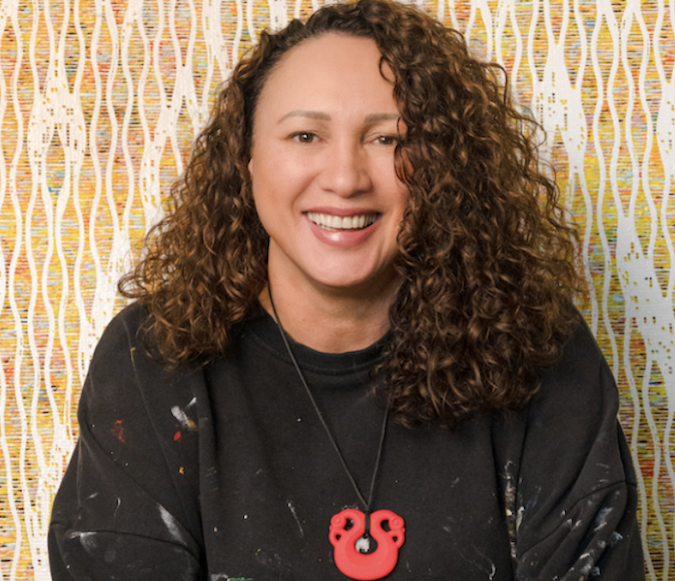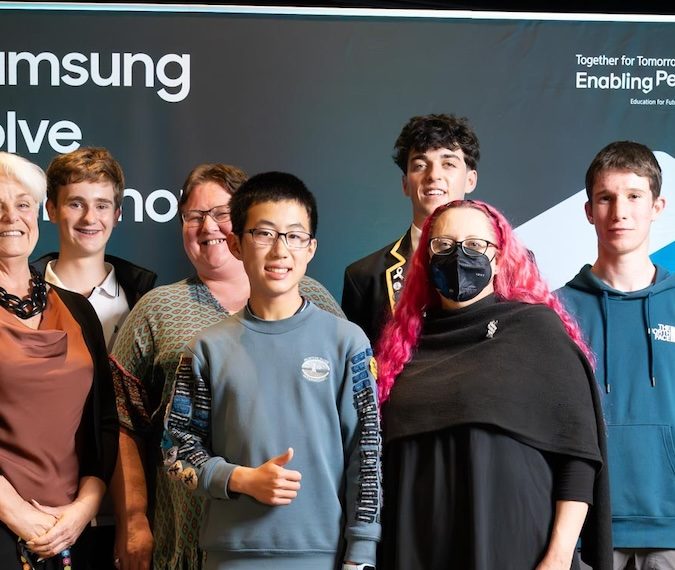More than a koru, part four: What role does Māoridom play in New Zealand’s design identity?

Design reflects our heritage and identity. So what role does Māoridom play in New Zealand’s design identity? Who is able to do it? What principles need to be abided by? And how does a young country like New Zealand embrace the modern world while retaining its traditions? In the final part of a series, we float down the country’s cultural currents with Māori designers, educators and architects.
Paying homage but transcending tradition
How do designers mix traditional and contemporary while retaining cultural meaning and identity? How do we display deep meanings without just slapping a koru on something or watering it down for tourists?
Carin Wilson’s artwork at the new Māori television office in Auckland is one example of weaving culture with modern-day design.
Working with RCG, Wilson, who was the art director of the original Māori Television office created in 2004, came back on board to create new artwork for the space.
One piece was a sculpture created for the reception area called ‘Te Haerenga’, a four-panelled contemporary take on a tukutuku (latticework panels) and stemmed from the idea of a wakahuia (treasure or feather box).
“The whole digital deconstruction of a traditional piece of tukutuku, it’s iconographic in the sense that you’ll always see that panel design in a Maori wharenui. There’s a small group of tukutuku designs that every weaver learns,” Wilson says. “We took tukutuku and looked at different materials, the building and colours and so on, figured out a way to recreate the tukutuku motif but bring it into a completely contemporary idiom.”
First impressions
Threaded’s Clarke has recently moved home, back up north from Auckland. And when Māori clients ask her to see them for a korero about projects, she says she wonders what they will think when they see her.
“I do feel anxious that I don’t look Māori. Hopefully, our work transcends their first initial perceptions.”
She says getting the stories and representation right without looking ‘token’ is a big thing.

“…because they [iwi] walk with it and because it will be challenged by people. Once it’s accepted it feels like the biggest success, you’re actually seeing people use it. It’s definitely a sense of pride.”
Asking Clarke if she feels pressure and responsibility, she says she does but concentrates on the job at hand.
“You have to extract the information that is important and make sure you’re representing that graphically. It’s just usually more spiritual and usually more ‘real’. I can’t explain it, and it’s usually the work we’re most proud of.”
Witehira says he acknowledges in his mahi his Māori and Pākehā ancestry.
“It’s not just about making things more Māori for me, it’s about bringing balance to this dream that some of our ancestors had of Māori and Pākehā coming together in Aotearoa, New Zealand, and both of us benefiting from it. Obviously, that hasn’t played out as well as it could have, but for me, it’s about bringing design into our daily life.”
For the Aotearoa House project, Witehira says the students – of which the majority were Pākehā – explored their own sense of identity through engaging with Māori culture.
“Everyone wants to figure out what their identity is, especially if you’re Pākehā – ‘I’m not British, I’m not European, I’m not tangata whena’ – there’s a lot of complexity around identity. That said that if you are a New Zealander, Māori culture is a part of who you are. The sooner you accept that and get comfortable with that, the easier it is being a New Zealander.”
Pākehā are often considered and concerned with engaging with Māori around design, says Witehira.
“They don’t want to do it inappropriately, do it the wrong way. Fear holds people back – both for Māori and Pākehā. I’m urban Māori and people assume I’m a native speaker – only seeking out Māori design did I became engaged with my culture. I went through things – language learning, etc – to help me feel comfortable.”
Cultural cringe
There was a huge outcry when American popstar Rihanna got a Māori-inspired tattoo in 2013, done the traditional way, with chisel and mallet. Mike Tyson, Robbie Williams and Ben Harper have also all had Māori-inspired designs while in New Zealand.
This pushback picks up on important question to do with identity and culture: who is able to get, or display, designs, such as Ta Moko, especially if they have with no knowledge of the design, significance or tools used? And how do we ensure Māori heritage and culture is preserved correctly.
Clarke says this a really hard question.
“My own opinion is that you can’t preserve it, that once you put something out there anyone can take it, reappropriate it and reuse it. Look at Robbie Williams and Rihanna’s tattoos – if people say it’s not their right to have one, what if they come here and have an experience?”
She gives the example of the 2016 film Moana as an example of Polynesian/Māori design and elements being misused.
“They’ve gone on Pinterest, taken lots of elements and used [them] the wrong way but they tried and what can you do? As long as we’re true to ourselves and listen to the clients and visually represent what they are asking, we can only talk through the projects we’ve worked on.”

Witehira’s work in Times Square, New York
An interesting point brought up by Dr Witehira during our discussions was in relation to Māori cultural advisors.
He says when he started graphic design school he couldn’t find any Māori design role models.
“Where I found what we might call ‘sophisticated design’ was done by Pākehā designers with Māori cultural advisors.”
He says what’s problematic is that normally the cultural advisors might be fluent in Māori, may have grown up in a Māori community or environment but they might not know anything about Māori art or design.
“There’s the assumption as I’m Māori, so I know Māori design. Often, I think their backgrounds aren’t the right ones to be bringing into these projects but it’s still the norm for design agencies … the people that should be in the roles should be the ones with Māori art, architecture and design backgrounds or iwi involved in the project – the mana whenua. They are the ones who are giving me advice, the stories they want to share and feel comfortable sharing.”
Witehira says to improve this situation he believes there needs to be more support and scholarships for Māori to engage in design; to “present young Māori with opportunities for different futures”.
Space to grow
Looking at the New Zealand business scene, companies are increasingly dedicating space – both literal and mental – to Māori design and understanding the importance of integrating Māori culture into the business.
One example is architecture firm Warren & Mahoney, which set up Te Matakīrea – the advanced Māori Design Unit – in 2016 with the help of Ngata Tapsell.
The goal of Te Matakīrea is to explore architectural opportunities “that are ambitious, modern and yet thoroughly grounded in the Māori world”, ensuring Māori values and ideas are embedded within projects from day one.
The unit has worked on projects so far for He Puna Karikari (Lincoln Hub) in Christchurch and Te Waonui O Te Mātauranga (Manukau Institute of Technology) and is made up of what Tapsell says is a true cross-section of modern New Zealand.
Tapsell, an associate at the firm, worked internationally for 12 years before returning home with ideas and experiences from working on projects for a number of indigenous and non-Western cultures.
He says one of the great challenges he faced upon his return was how does his culture, with 1000-odd years of history in New Zealand, embrace the modern world in a way that is grounded in that history and tradition but not restrained by it?
“If a culture does not grow to embrace the new and unknown, it risks irrelevance.”
Keen to explore the deepest conceptual underpinnings of Te Ao Māori, their architectural implications and their relevance in the modern world, Tapsell wants Te Matakīrea to ask the difficult questions about what it means to be Māori or indeed a New Zealander in 2018 and beyond.
“We should be challenging our clients to think of architecture as an opportunity for cultural growth … to us, the Māori world view is inextricably linked to New Zealand’s architectural identity.”
While the unit is new, Tapsell is quick to say Te Matakīrea is not a box-ticking exercise for Warren and Mahoney.
“As a practice we feel a great responsibility to advance New Zealand socially and culturally through architecture, and to do that we need to be pushing some boundaries … our focus is on new design outcomes for a new world, while understanding and respecting the journey to date. It’s a big challenge but we have a team of talented and driven individuals who are up to the task.”
Air New Zealand and Designworks took home the Ngā Aho Award at the 2017 Best Awards for Te Tohu, a pin meant to identify te reo Māori speakers in the cabin crew.
The Designworks team chose a traditional carver’s approach melded with modern design, with a waha (mouth) meant to signify the oral origins of te reo Māori, while still leaving the overall design open to individual interpretation.
Much of the Tohu was designed by expert carver Clive Fugill at the New Zealand Māori Arts and Crafts Institute, Te Puia, in Rotorua, with the process of commissioning and launching the pins taking about a year and involving partnerships with groups including Te Taura Whiri i te reo Māori (the Māori Language Commission).
Andrew Baker, Air New Zealand’s cultural development manager, told Idealog in November that the design collaboration will hopefully help preserve the very bedrock of Aotearoa’s culture.
“The Tohu is not only a symbol to identify te reo Māori speakers, but also one that acknowledges the importance of te reo Māori to us all, and champion its growth and prosperity into the future. This project highlighted the fundamental role that design has to play in protecting and communicating our New Zealand identity.”
In the publishing arena, The Spinoff launched Ātea, a dedicated Māori perspectives section on its site in October last year.
Editor Leonie Hayden spoke to StopPress two weeks after the launch, explaining that as Ātea’s mission is to have the indigenous perspective as the default, all contributors will be Māori, or identify strongly with Māori communities.
When asked her thoughts on Māori representation in mainstream media, Hayden says she sees it as a “two steps forward, one step back” type situation.
She says while mainstream media can have the best of intentions, “announcing they will spell te reo Māori correctly by using macrons”, they then use the freedom of speech, “to defend their right to publish racist cartoons.”
However, Hayden says there is progress being made.
“During Māori Language Week there is amazing content being produced all around the country, and once it’s over you see Māori commentators and di ffrent people being used. Each time you do see a tiny improvement, yet we are all responsible for a big improvement.”
She commended RNZ, in particular Morning Report presenter Guyon Espiner, for using te reo, saying “a non-Māori broadcaster using reo, it’s normalising it for people”. RNZ has taken a stand and committed to using the language. And the current debate over making te reo Māori compulsory in schools shows that New Zealanders are at least thinking about the issue – and recognising the culture.
He tangata, he tangata, he tangata
Collaboration, process, respect and telling stories are all integral parts of Maori design and identity in New Zealand.
Clarke believes that embracing the modern and offering work that has a contemporary twist is the future.
“You can look at most other Māori designers that are pushing the boundaries – people like Johnson Witehira, Lisa Reihana and Shane Hansen – they are really trying to operate in a space that is paying homage to, but transcending, tradition.”
Witehira himself sums it up nicely: “We may look back to Europe and America – I look to those two too because I love their design – but if we want to find ourselves we have to find it here.”




